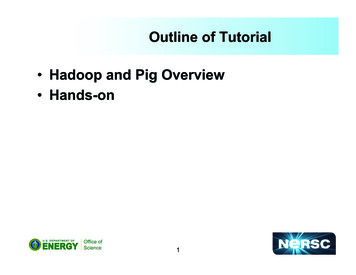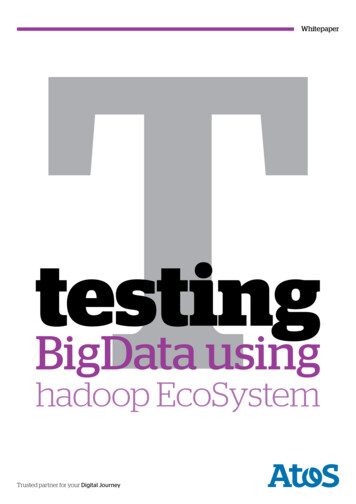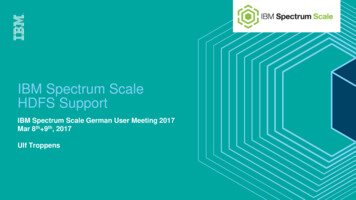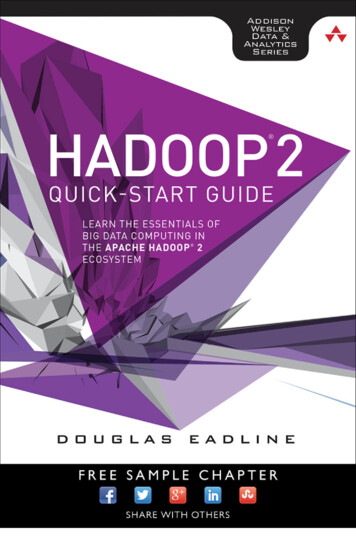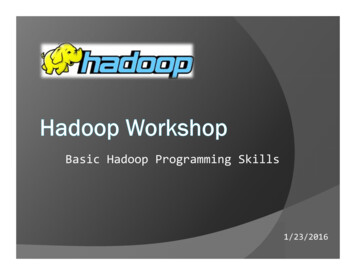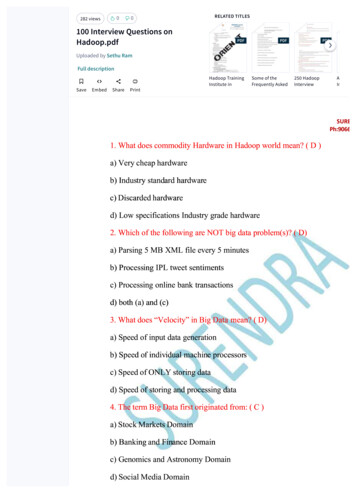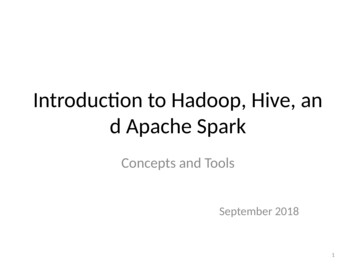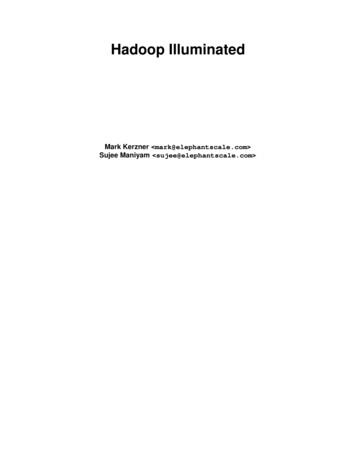
Transcription
Hadoop IlluminatedMark Kerzner mark@elephantscale.com Sujee Maniyam sujee@elephantscale.com
Hadoop Illuminatedby Mark Kerzner and Sujee Maniyam
DedicationTo the open source communityThis book on GitHub ]Companion project on GitHub [https://github.com/hadoop-illuminated/HI-labs]i
AcknowledgementsTo Hadoop community Apache Hadoop [http://wiki.apache.org/hadoop/PoweredBy] is an open source software from ApacheSoftware Foundation [http://wiki.apache.org/hadoop/PoweredBy]. Apache, Apache Hadoop, and Hadoop are trademarks of The Apache Software Foundation. Used withpermission. No endorsement by The Apache Software Foundation is implied by the use of these marks For brevity we will refer Apache Hadoop as HadoopFrom MarkI would like to express gratitude to my editors, co-authors, colleagues, and bosses who shared the thornypath to working clusters - with the hope to make it less thorny for those who follow. Seriously, folks,Hadoop is hard, and Big Data is tough, and there are many related products and skills that you need tomaster. Therefore, have fun, provide your feedback ], and I hope you will find the book entertaining."The author's opinions do not necessarily coincide with his point of view." - Victor Pelevin, "GenerationP" [http://en.wikipedia.org/wiki/Generation %22%D0%9F%22]From SujeeTo the kind souls who helped me along the way.Copyright 2013-2016 Elephant Scale LLCLicensed under the Apache License, Version 2.0 (the "License"); you may not use this file except incompliance with the License. You may obtain a copy of the License athttp://www.apache.org/licenses/LICENSE-2.0Unless required by applicable law or agreed to in writing, software distributed under the License is distributed on an "AS IS" BASIS, WITHOUT WARRANTIES OR CONDITIONS OF ANY KIND, eitherexpress or implied. See the License for the specific language governing permissions and limitations underthe License.ii
Table of Contents1. Who is this book for? . 11.1. About "Hadoop illuminated" . 12. About Authors . 23. Big Data . 53.1. What is Big Data? . 53.2. Human Generated Data and Machine Generated Data . 53.3. Where does Big Data come from . 53.4. Examples of Big Data in the Real world . 63.5. Challenges of Big Data . 73.1. Taming Big Data . 84. Hadoop and Big Data . 94.1. How Hadoop solves the Big Data problem . 94.2. Business Case for Hadoop . 105. Hadoop for Executives . 126. Hadoop for Developers . 147. Soft Introduction to Hadoop . 167.1. Hadoop HDFS MapReduce . 167.2. Why Hadoop? . 167.3. Meet the Hadoop Zoo . 187.4. Hadoop alternatives . 217.5. Alternatives for distributed massive computations . 227.6. Arguments for Hadoop . 238. Hadoop Distributed File System (HDFS) -- Introduction . 248.1. HDFS Concepts . 248.1. HDFS Architecture . 279. Introduction To MapReduce . 309.1. How I failed at designing distributed processing . 309.2. How MapReduce does it . 319.3. How MapReduce really does it . 319.1. Understanding Mappers and Reducers . 329.4. Who invented this? . 349.5. The benefits of MapReduce programming . 3410. Hadoop Use Cases and Case Studies . 3510.1. Politics . 3510.2. Data Storage . 3510.3. Financial Services . 3510.4. Health Care . 3610.5. Human Sciences . 3710.6. Telecoms . 3710.7. Travel . 3810.8. Energy . 3810.9. Logistics . 3910.10. Retail . 4010.11. Software / Software As Service (SAS) / Platforms / Cloud . 4010.12. Imaging / Videos . 4110.13. Online Publishing , Personalized Content . 4211. Hadoop Distributions . 4411.1. The Case for Distributions . 4411.2. Overview of Hadoop Distributions . 4411.3. Hadoop in the Cloud . 4512. Big Data Ecosystem . 47iii
Hadoop Illuminated13.14.15.16.17.12.1. Getting Data into HDFS .12.2. Compute Frameworks .12.3. Querying data in HDFS .12.4. SQL on Hadoop / HBase .12.5. Real time querying .12.6. Stream Processing .12.7. NoSQL stores .12.8. Hadoop in the Cloud .12.9. Work flow Tools / Schedulers .12.10. Serialization Frameworks .12.11. Monitoring Systems .12.12. Applications / Platforms .12.13. Distributed Coordination .12.14. Data Analytics Tools .12.15. Distributed Message Processing .12.16. Business Intelligence (BI) Tools .12.17. YARN-based frameworks .12.18. Libraries / Frameworks .12.19. Data Management .12.20. Security .12.21. Testing Frameworks .12.22. Miscellaneous .Business Intelligence Tools For Hadoop and Big Data .13.1. The case for BI Tools .13.2. BI Tools Feature Matrix Comparison .13.3. Glossary of terms .Hardware and Software for Hadoop .14.1. Hardware .14.2. Software .Hadoop Challenges .15.1. Hadoop is a cutting edge technology .15.2. Hadoop in the Enterprise Ecosystem .15.3. Hadoop is still rough around the edges .15.4. Hadoop is NOT cheap .15.5. Map Reduce is a different programming paradigm .15.6. Hadoop and High Availability .Publicly Available Big Data Sets .16.1. Pointers to data sets .16.2. Generic Repositories .16.3. Geo data .16.4. Web data .16.5. Government data .Big Data News and Links .17.1. news sites .17.2. blogs from hadoop vendors 5555758585960606060606061626262636464666666
List of .8.5.8.6.9.1.9.2.Tidal Wave of Data . 6Too Much Data . 9Scaling Storage . 10Hadoop Job Trends . 14Hadoop coin . 16Will you join the Hadoop dance? . 17The Hadoop Zoo . 19Cray computer . 25HDFS file replication . 26HDFS master / worker design . 27HDFS architecture . 27Disk seek vs scan . 28HDFS file append . 29Dreams . 30MapReduce analogy : Exit Polling . 33v
List of Tables6.1. Hadoop Roles .7.1. Comparison of Big Data .11.1. Hadoop Distributions .12.1. Tools for Getting Data into HDFS .12.2. Hadoop Compute Frameworks .12.3. Querying Data in HDFS .12.4. SQL Querying Data in HDFS .12.5. Real time queries .12.6. Stream Processing Tools .12.7. NoSQL stores for Big Data .12.8. Hadoop in the Cloud .12.9. Work flow Tools .12.10. Serialization Frameworks .12.11. Tools for Monitoring Hadoop .12.12. Applications that run on top of Hadoop .12.13. Distributed Coordination .12.14. Data Analytics on Hadoop .12.15. Distributed Message Processing .12.16. Business Intelligence (BI) Tools .12.17. YARN-based frameworks .12.18. Libraries / Frameworks .12.19. Data Management .12.20. Security .12.21. Testing Frameworks .12.22. Miscellaneous Stuff .13.1. BI Tools Comparison : Data Access and Management .13.2. BI Tools Comparison : Analytics .13.3. BI Tools Comparison : Visualizing .13.4. BI Tools Comparison : Connectivity .13.5. BI Tools Comparison : Misc .14.1. Hardware Specs 454555656565758
Chapter 1. Who is this book for?1.1. About "Hadoop illuminated"This book is our experiment in making Hadoop knowledge available to a wider audience. We want thisbook to serve as a gentle introduction to Big Data and Hadoop. No deep technical knowledge is neededto go through the book. It can even be a bedtime read :-)The book is freely available. It is licensed under Creative Commons Attribution-NonCommercial-ShareAlike 3.0 Unported License deed.en US]."Hadoop Illuminated" is a work in progress. It is a 'living book'. We will keep updating the book to reflectthe fast-moving world of Big Data and hadoop. So keep checking back.We appreciate your feedback. You can follow it on Twitter, discuss it in Google Groups, or send yourfeedback via email. Twitter : @HadoopIllumint [https://twitter.com/HadoopIlluminat] Google Group : Hadoop Illuminated Google group ] Email Authors Directly : authors@hadoopilluminated.com [mailto:authors@HadoopIlluminated.com] Book GitHub : github.com/hadoop-illuminated/hadoop-book ] Source Code on GitHub : github.com/hadoop-illuminated/HI-labs [https://github.com/hadoop-illuminated/HI-labs]1
Chapter 2. About AuthorsHello from Mark and SujeeHI there!Welcome to Hadoop Illuminated. This book is brought to you by two authors -- Mark Kerzner and SujeeManiyam. Both of us have been working in Hadoop ecosystem for a number of years. We have implemented Hadoop solutions and taught training courses in Hadoop. We both benefited from Hadoop and the opensource community tremendously. So when we thought about writing a book on Hadoop, we choose to do itin the fully open source way! It is a minuscule token of thanks from both of us to the Hadoop community.Mark Kerzner (Author)Mark Kerzner is an experienced/hands-on Big Data architect. He has been developing software for over 20years in a variety of technologies (enterprise, web, HPC) and for a variety of verticals (Oil and Gas, legal,trading). He currently focuses on Hadoop, Big Data, NoSQL and Amazon Cloud Services. His clientsinclude Bay Area startups, T-Mobile, GHX, Cision, and lately Intel, where he created and delivered BigData training.Mark stays active in the Hadoop / Startup communities. He runs the Houston Hadoop Meetup, where hepresents and often trains. Mark’s company SHMsoft has won multiple innovation awards, and is a clientof Houston Incubator HTC, where Mark is involved with many startup initiatives.2
About AuthorsMark contributes to a number of Hadoop-based projects, and his open source projects can be foundon GitHub [http://github.com/markkerzner]. He writes about Hadoop and other technologies in his blog[http://shmsoft.blogspot.com/].Mark does Hadoop training for individuals and corporations; his classes are hands-on and draw heavilyon his industry experience.Links:LinkedIn [https://www.linkedin.com/in/markkerzner] GitHub [https://github.com/markkerzner] Personal blog [http://shmsoft.blogspot.com/] Twitter [https://twitter.com/markkerzner]Sujee Maniyam (Author)Sujee Maniyam is an experienced/hands-on Big Data architect. He has been developing software for thepast 12 years in a variety of technologies (enterprise, web and mobile). He currently focuses on Hadoop,Big Data and NoSQL, and Amazon Cloud Services. His clients include early stage startups and enterprisecompanies.Sujee stays active in the Hadoop / Open Source community. He runs a developer focused Meetup called'Big Data Gurus' [http://www.meetup.com/BigDataGurus/]. He has also presented at a variety of Meetups.Sujee contributes to Hadoop projects and his open source projects can be found on GitHub. He writesabout Hadoop and other technologies on his website [http://www.sujee.net/]Sujee does Hadoop training for individuals and corporations; his classes are hands-on and draw heavilyon his industry experience.Links:LinkedIn [http://www.linkedin.com/in/sujeemaniyam] GitHub [https://github.com/sujee] Tech writings [http://sujee.net/tech/articles/] Tech talks [http://sujee.net/tech/talks/] BigDataGuru meetup [http://www.meetup.com/BigDataGurus/]Rebecca Kerzner (Illustrator)The delightful artwork appearing in this book was created by Rebecca Kerzner. She is seventeen and studies at Beren Academy in Houston, TX. She has attended the Glassell school of art for many summers.Her collection of artwork can be seen here 0/RebeccaSArt].Rebecca started working on Hadoop illustrations two years ago, when she was fifteen.It is interesting to follow her artistic progress. For example, the first version of the"Hadoop Zoo" can be found here ?banner pwa]. Note the programmer's kids who"came to see the Hadoop Zoo" are all pretty young. But as the artist grew, so also did her heroes, andin the current version of the same sketch ?banner pwa] you can see the same characters, butolder, perhaps around seventeen years of age. Even the Hadoop elephant appears more mature and serious.All of Rebecca's Hadoop artwork can be viewed here 850/albums/5850230050814801649?banner pwa].3
About AuthorsContributorsWe would like to thank the following people who helped us improve this book. Ben Burford : github.com/benburford [https://github.com/benburford] Yosef Kerzner 23]4
Chapter 3. Big Data3.1. What is Big Data?You probably heard the term Big Data -- it is one of the most hyped terms now. But what exactly is big data?Big Data is very large, loosely structured data set that defies traditional storage3.2. Human Generated Data and Machine Generated DataHuman Generated Data is emails, documents, photos and tweets. We are generating this data faster thanever. Just imagine the number of videos uploaded to You Tube and tweets swirling around. This data canbe Big Data too.Machine Generated Data is a new breed of data. This category consists of sensor data, and logs generatedby 'machines' such as email logs, click stream logs, etc. Machine generated data is orders of magnitudelarger than Human Generated Data.Before 'Hadoop' was in the scene, the machine generated data was mostly ignored and not captured. It isbecause dealing with the volume was NOT possible, or NOT cost effective.3.3. Where does Big Data come fromOriginal big data was the web data -- as in the entire Internet! Remember Hadoop was built to index theweb. These days Big data comes from multiple sources.5
Big Data Web Data -- still it is big data Social media data : Sites like Facebook, Twitter, LinkedIn generate a large amount of data Click stream data : when users navigate a website, the clicks are logged for further analysis (like navigation patterns). Click stream data is important in on line advertising and and E-Commerce sensor data : sensors embedded in roads to monitor traffic and misc. other applications generate a largevolume of data Connected Devices : Smart phones are a great example. For example when you use a navigation application like Google Maps or Waze, your phone sends pings back reporting its location and speed (thisinformation is used for calculating traffic hotspots). Just imagine hundres of millions (or even billions)of devices consuming data and generating data.3.4. Examples of Big Data in the Real worldSo how much data are we talking about? Facebook : has 40 PB of data and captures 100 TB / day Yahoo : 60 PB of data Twitter : 8 TB / day EBay : 40 PB of data, captures 50 TB / dayFigure 3.1. Tidal Wave of Data6
Big Data3.5. Challenges of Big DataSheer size of Big DataBig data is. well. big in size! How much data constitute Big Data is not very clear cut. So lets not getbogged down in that debate. For a small company that is used to dealing with data in gigabytes, 10TB ofdata would be BIG. However for companies like Facebook and Yahoo, peta bytes is big.Just the size of big data, makes it impossible (or at least cost prohibitive) to store in traditional storagelike databases or conventional filers.We are talking about cost to store gigabytes of data. Using traditional storage filers can cost a lot of moneyto store Big Data.Big Data is unstructured or semi structuredA lot of Big Data is unstructured. For example click stream log data might look likeuser id, page, referrer pageLack of structure makes relational databases not well suited to store Big Data.time stamp,Plus, not many databases can cope with storing billions of rows of data.No point in just storing big data, if we can't process itStoring Big Data is part of the game. We have to process it to mine intelligence out of it. Traditional storagesystems are pretty 'dumb' as in they just store bits -- They don't offer any processing power.The traditional data processing model has data stored in a 'storage cluster', which is copied over to a'compute cluster' for processing, and the results are written back to the storage cluster.This model however doesn't quite work for Big Data because copying so much data out to a computecluster might be too time consuming or impossible. So what is the answer?One solution is to process Big Data 'in place' -- as in a storage cluster doubling as a compute cluster.7
Big Data3.1. Taming Big DataSo as we have seen above, Big Data defies traditional storage. So how do we handle Big Data? In the nextchapter we will see about Chapter 4, Hadoop and Big Data [9]8
Chapter 4. Hadoop and Big DataMost people will consider hadoop because they have to deal with Big Data. See Chapter 3, Big Data [5]for more.Figure 4.1. Too Much Data4.1. How Hadoop solves the Big Data problemHadoop is built to run on a cluster of machinesLets start with an example. Say we need to store lots of photos. We will start with a single disk. When weexceed a single disk, we may use a few disks stacked on a machine. When we max out all the disks on asingle machine, we need to get a bunch of machines, each with a bunch of disks.9
Hadoop and Big DataFigure 4.2. Scaling StorageThis is exactly how Hadoop is built. Hadoop is designed to run on a cluster of machines from the get go.Hadoop clusters scale horizontallyMore storage and compute power can be achieved by adding more nodes to a Hadoop cluster. This eliminates the need to buy more and more powerful and expensive hardware.Hadoop can handle unstructured / semi-structured dataHadoop doesn't enforce a 'schema' on the data it stores. It can handle arbitrary te
For brevity we will refer Apache Hadoop as Hadoop From Mark I would like to express gratitude to my editors,

